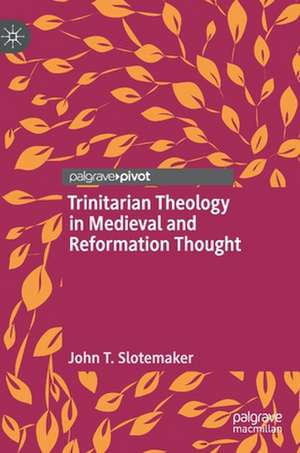Trinitarian Theology in Medieval and Reformation Thought
Autor John T. Slotemakeren Limba Engleză Hardback – 4 iul 2020
Preț: 456.10 lei
Nou
Puncte Express: 684
Preț estimativ în valută:
87.29€ • 90.79$ • 72.06£
87.29€ • 90.79$ • 72.06£
Carte tipărită la comandă
Livrare economică 14-28 aprilie
Preluare comenzi: 021 569.72.76
Specificații
ISBN-13: 9783030477899
ISBN-10: 3030477894
Pagini: 131
Ilustrații: XIV, 131 p.
Dimensiuni: 148 x 210 mm
Greutate: 0.45 kg
Ediția:1st ed. 2020
Editura: Springer International Publishing
Colecția Palgrave Macmillan
Locul publicării:Cham, Switzerland
ISBN-10: 3030477894
Pagini: 131
Ilustrații: XIV, 131 p.
Dimensiuni: 148 x 210 mm
Greutate: 0.45 kg
Ediția:1st ed. 2020
Editura: Springer International Publishing
Colecția Palgrave Macmillan
Locul publicării:Cham, Switzerland
Cuprins
1. Introduction.- 2. Theological Epistemology.- 3. Emanations and Relations.- 4. Persons and Personal Distinction.- 5. Conclusion.
Notă biografică
John T. Slotemaker is Associate Professor of Medieval Christianity at Fairfield University. His previous books include Anselm of Canterbury and the Search for God (2018), and with Jeffrey C. Witt, Augustine in Late Medieval Philosophy and Theology (2017), Robert Holcot (2016), and A Companion to the Theology of John Mair (2015).
Textul de pe ultima copertă
This book is an introduction to trinitarian theology as it developed from the late medieval period. John T. Slotemaker presents an overview of the central aspects of trinitarian theology by focusing on four themes: theological epistemology, the emanations in God, the divine relations, and the Trinity of persons. He does so by exploring a broad range of theological opinions on each subject and delineating the options that existed for medieval theologians from the early thirteenth century through the sixteenth. He argues that despite the diversity of opinion on a given subject, there is a normative theological center that grounds late medieval trinitarian theology. This center consists of theological developments involving the adoption of Peter Lombard’s Sentences as a theological textbook, the conciliar decisions of Lateran IV, and a shared Aristotelian philosophical background of Western trinitarian theology.
Caracteristici
Provides an introduction to medieval and early modern trinitarian theology Argues that medieval and early modern trinitarian theologies share much in common Engages with a diverse group of thinkers to provide the reader with different philosophical and theological views between 1000 and 1550
